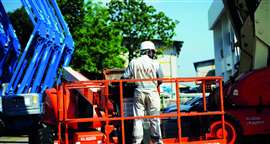What are the CO2 emission strategies of Japan’s big rental firms?
20 November 2024
How are Japan’s major rental firms addressing environmental sustainability? Jeff Pao, Rental Briefing editor, reports on what they are saying publicly.
Japan’s ‘big four’ construction equipment rental companies—Aktio, Kanamoto, Nishio Rent All and Nikken—have announced different sustainability plans to help the country meet its goal of cutting greenhouse gas (GHG) emissions by 46% by 2030 from 2013.
Of the four, only Kanamoto has published actual targets of carbon emission reductions (see below), although all report actions and initiatives in support of carbon reduction and environmental sustainability.
Aktio Holdings Corp, the largest equipment rental company in Japan by revenue, said it has taken proactive measures to reduce emissions of environmental pollutants. It has adopted machines that can reduce emissions and is working with manufacturers in the joint development of rechargeable battery-powered lighting towers.
It offers a wide range of green equipment, such as biodiesel generators, solar powered modular accommodation and vans equipped with solar panels and power storage systems. The company also started renting a Takeuchi battery powered mini excavator, the TB20e, in November this year.
 Photo: Aktio Holdings
Photo: Aktio Holdings
The company nurtures the ‘Forest of Aktio’ in Yamanashi, Japan, to help reduce greenhouse gas emissions.
Nishio Holdings, the owner of the Japanese rental company Nishio Rent All, said it is leading the way in promoting the transition to a decarbonised society.
It is focusing on wooden modular buildings and the electrification of construction machinery.
The company noted that as forests absorb carbon dioxide from the atmosphere, carbon remains trapped in the modules used in its warehouse facilities. It said it could quantify such a decarbonisation effort.
In the coming three years, the company will add 250 electric construction machines to its fleet and encourage the use of electric equipment by increasing the capacity of its on-site recharging facilities for 100 machines.
The company also said it would consider adopting Task Force on Climate Related Financial Disclosures (TCFD) during its current three year business plan, which ends in September 2026.
Customers need encouragement
Kanamoto is perhaps the most advanced in its sustainability goals of the four companies. Sustainability occupies a central place in its annual reports (which are available in English) and it is aligning its initiatives to the UN’s key sustainable development goals (SDGs).
It has set targets for the business on its Scope 1 and Scope 2 emissions, in each case targeting a 50% reduction in emissions by 2030 from a base line of 2013.
In addition, its annual fleet replacement programme sees 3,000 pieces of equipment complying with the latest engine emission regulations replacing existing machines.
It said this investment optimises operational processes via efficient vehicle allocation and Digital Transformation (DX) initiatives and steadily advances decarbonisation.
However, in an earlier interview with IRN, Tetsuo Kanamoto, president of Kanamoto, acknowledged that the company’s percentage of electric-driven equipment remained low.
He said many customers in Japan do not want to pay more for alternative-powered equipment. He added that the company will consider increasing the percentage of electric equipment when more customers are ready to switch from conventionally powered machines.
Nikken is taking a slightly different approach by using carbon offset programmes to help its customers achieve net zero carbon emissions. In June this year, Nikken - a wholly-owned subsidiary of Mitsubishi Corp - joined forces with Sustineri, a Japanese climate technology company, to launch a carbon offsetting programme to encourage its customers to reduce carbon emissions.
Under the initiative, when customers return equipment, they can report to it how much fuel they have used, with offsetting managed by Sustineri, depending on the customer’s budget and decarbonisation goals. It said its customers will receive a certificate proving their sustainability efforts.
Japan’s carbon-neutral plan
In October 2020, Japanese Prime Minister Yoshihide Suga announced Japan’s plan to realize a carbon-neutral society by 2050.
In April 2021, the Japanese government vowed to reduce GHG emissions by 46% by 2030 from 2013 levels, a significant increase from its previous commitment of a 26% reduction.
According to the latest data released by the European Commission’s Emissions Database for Global Atmospheric Research (EDGAR), Japan has successfully cut GHG emissions by 27.1% to 1.041 billion tonnes in 2023 from 1.428 billion tonnes in 2013.
Over the past decade, Japan’s GHGs have mainly been produced by the electricity and heat production (38.4%), road transportation (18.9%), and manufacturing and construction (15%) sectors.
Equipment rental companies have helped the manufacturing and construction sector reduce GHG emissions.
From 2013 to 2023, the reduction of Japan’s GHG emissions in:
- Electricity and heat production: -35.8%
- Road transportation: -18.9%
- Manufacturing and construction: -27.9%
Japan needs to cut emissions by another 26% from last year’s level to achieve its 2030 decarbonisation goal.
 Carbon emissions from the manufacturing and construction sector by country (Source: EDGAR)
Carbon emissions from the manufacturing and construction sector by country (Source: EDGAR)
STAY CONNECTED



Receive the information you need when you need it through our world-leading magazines, newsletters and daily briefings.
CONNECT WITH THE TEAM






